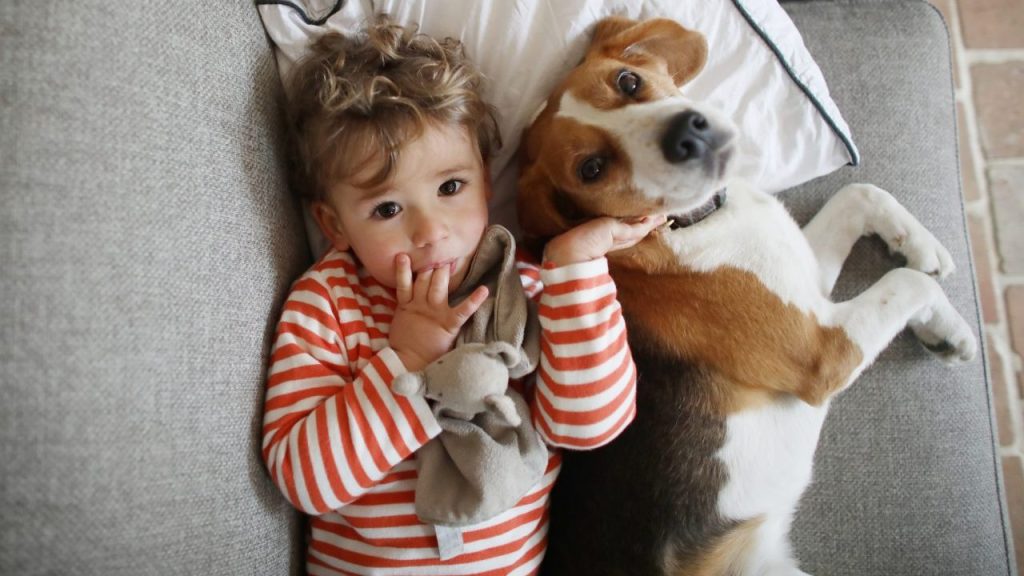If you’re a parent, it’s highly likely your kids have been begging you (a classic canine move) for a dog ever since they could talk. Finally, the day came when you agreed. You started the search and managed to find a family-friendly pup to call your own. Now that your new furry family member is home, your kids can’t stop playing with their pooch. But keeping the peace between children and canines is tougher than it might seem. Part of being a responsible parent (and a dog owner) is teaching your children how to be gentle with dogs. Instructing your kids about proper dog handling, respect, and empathy not only fosters a loving relationship but also keeps everyone safe.
Helping children be gentle with dogs
We’re going to outline five important lessons parents can teach their children to help them interact more peacefully with dogs. Additionally, we’ll provide tips on training dogs to behave appropriately around children, creating an amicable environment for both fur babies and human kids.
Lesson 1: Respect personal space
Children should understand that dogs, like humans, have their personal space. Teach them to recognize when a dog wants to be left alone and needs space. Explain that some dogs may show signs of stress or discomfort when approached or touched in certain ways. Encourage children to observe the dog’s body language, such as stiff posture, lip licking, or tail tucking, which may indicate the dog is feeling anxious. Teach them to respect the dog’s boundaries and give them the space they need.
Lesson 2: Gentle touch and petting
Demonstrate and explain to children the importance of gentle touch when interacting with dogs. Instruct them to use soft strokes and avoid pulling on the dog’s fur, tail, or ears. Teach children to approach the dog calmly, allowing the dog to sniff their hand before petting. Encourage them to pet the dog along its back or chest, avoiding sensitive areas like the face or belly. Remind them to be aware of the dog’s responses and to stop petting if the dog shows signs of discomfort, such as growling, snapping, or trying to move away.
Lesson 3: Proper handling techniques
Teach children how to handle dogs properly, especially when picking them up (small dogs only!) or playing with them. If you have a small dog, instruct your kids to approach the pup gently and to support the dog’s body by placing one hand under the chest and the other supporting the hindquarters. Explain that this provides stability and prevents the dog from feeling insecure or uncomfortable.
Teach children to avoid rough play, such as pulling the dog’s tail or ears, as it can lead to negative reactions from the dog. Encourage them to engage in gentle play, use appropriate toys, and always be mindful of the dog’s size and strength.
Also, discourage kids from getting their faces too close to the dog’s mouth, as this could trigger the dog and cause an unwanted reaction.
Lesson 4: Understanding dog communication
Educate children about basic dog communication signals to help them understand the dog’s emotions and needs. Teach them to recognize signs of friendliness, such as relaxed body posture, wagging tail, and open mouth. Additionally, explain signals of discomfort or fear, such as growling, raised hackles, or a tucked tail. By understanding these cues, children can adapt their behavior and respond appropriately to the dog’s needs, ensuring a positive and safe interaction.
Lesson 5: Safety rules
Establish safety rules that children should follow when interacting with dogs. Teach them to avoid bothering dogs that are eating, sleeping, or chewing on toys or treats. Explain that dogs may become protective or defensive during these times. Emphasize the importance of not approaching strange dogs without the owner’s permission, as not all dogs are comfortable with unfamiliar people. Encourage children to always treat dogs with kindness, patience, and respect, even if they are excited or playful.
Training your dog to behave around children
To create a safe and positive environment for both your dog and your kids, it’s important to train your dog to behave appropriately around little ones. Start with basic obedience training to establish a foundation of good manners. Teach the dog commands like “sit,” “stay,” and “leave it” to ensure they understand and respond to cues from both adults and children. Supervise all interactions between dogs and children, providing guidance and redirecting the dog’s attention if necessary. Reward calm and gentle behavior. Consistency and positive reinforcement will help your dog associate your kids with positive experiences, fostering peaceful coexistence.
Helping kids and dogs coexist
Teaching children to be gentle with dogs is essential for fostering a loving and safe relationship between the two. By imparting the lessons of respect for personal space, gentle touch, proper handling techniques, understanding dog communication, and following safety rules, parents can help children develop empathy, responsibility, and a lifelong bond with their furry companions. In addition, training dogs to behave around children ensures a positive and secure environment for both the dog and the child. Together, these efforts create a harmonious and joyful experience for the entire family.








